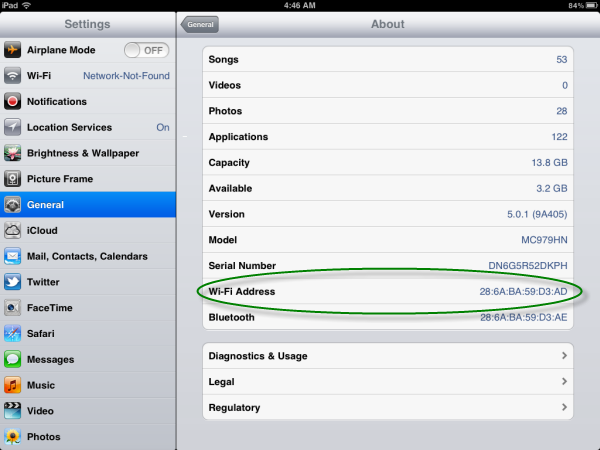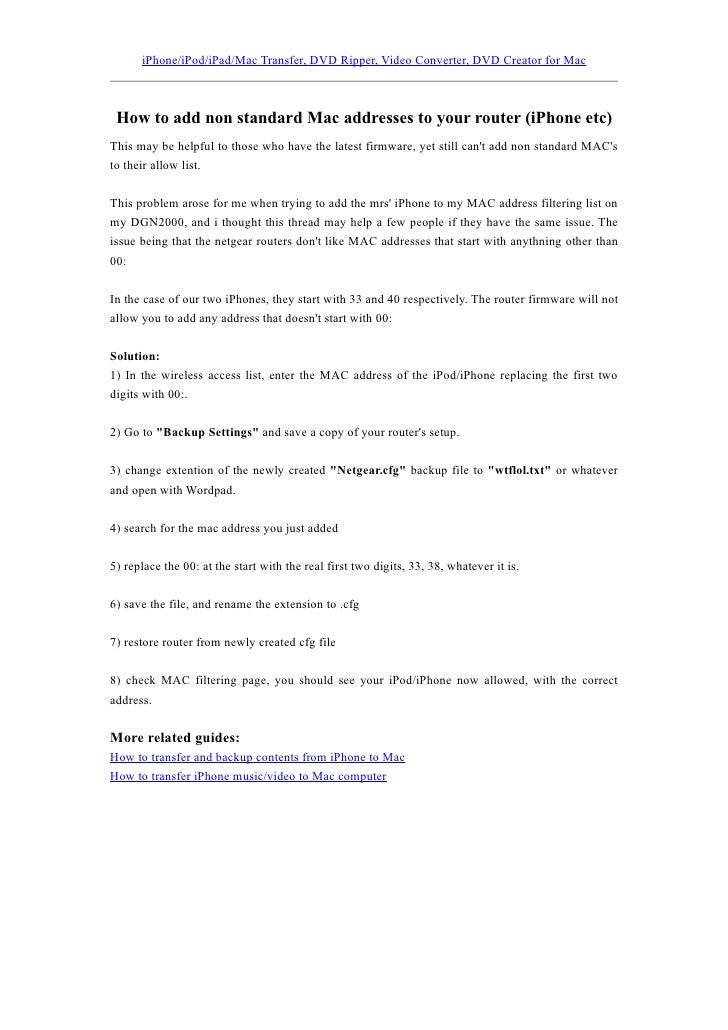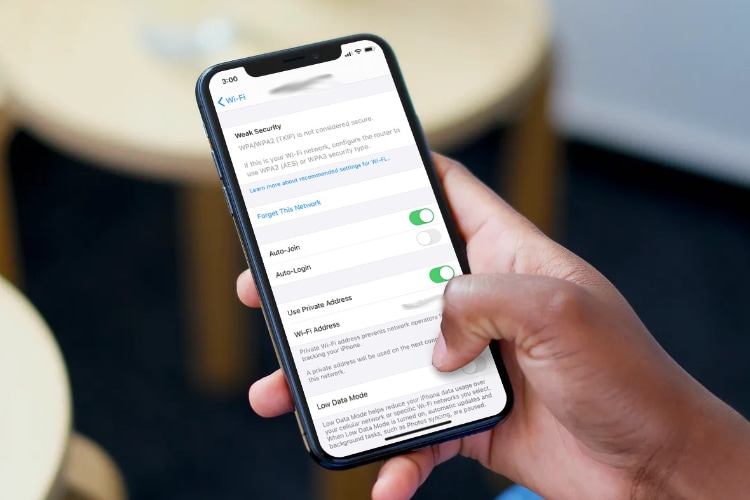Sep 03, 2013 Since ethernet uses MAC addresses, the sender needs to get the MAC address of the next hop. There is a special protocol ARP (address resolution protocol) that is used for that. Once the sender has retrieved the MAC address of the next hop, he writes that target MAC address into the packet and sends the packet. Sync iPhone contacts to Mac Address book: Set up iCloud and enable your iCloud account on your Mac. Click the little apple icon on the top left of your Mac, choose System Preferences, click iCloud, and select Contacts (Address book) you want to enable. Then you will see all the iPhone contacts are synced to your Mac Address book.
If you are a network administrator, you probably have to deal with mac addresses often. MAC address is required to identify a device on a particular network and manage its connection. Although it's similar to the device ID, but it's specifically used for network connection.
You can use it to restrict network access to specific devices, apply network rules, and even change it to spoof a different device. I am sure you can see how important it is to know your device's MAC address. Therefore, today I will show you 4 ways to find MAC address on any Android phone.
1. Find MAC address from the device information
The quickest way to find MAC address on Android is to look for it in the About device section.
Here's how to access it:
- Go to 'Settings' and tap on 'About device'.
- Here tap on 'Status' and you'll find the MAC address under the 'WiFi MAC address'

You can tap and hold on the MAC address to copy it and paste it anywhere you like.
2. Find MAC address from the WiFi settings
Alternatively, you can also find MAC address from WiFi advanced settings. Follow the below instructions:
- Access 'Settings' and tap on 'Connections' (or WiFi and networks) option.
- Now tap on 'Advanced' button at the top-right corner.
- In the Advanced settings, you'll find the MAC address at the bottom.
3. Use a dialer code to find MAC Address
If you are one of those geeky users who like using codes, then you'll surely like this option. Like many other secret Android codes, there is also a dial pad code to find MAC address on Android. Here's is what you need to do:
Open up the dial pad (the app you use for calling) and enter the code *#*#232338#*#*. A tiny window will open up to show your mac address.
Note: This trick may not work on some Android phones. For example, it doesn't work on my Samsung device.
4. Use a MAC address finder app
If you frequently need to look for the MAC address of your Android phone, then using a dedicated app might be a better option. There are many apps for this purpose, but I recommend What's my MAC address for its simplicity.
Mac Address For Iphone 7
Open pgm files. Just install and launch the app and it will show the device MAC address on the top. Additionally, it also shows SSID and BSSID (WiFi MAC address), which could also be useful in many situations. If you need to copy any of the information, just tap and hold on it.
Ending thoughts
These are all the methods I know to find MAC address on Android devices. I particularly like the first method on this list as it's easier to access and you also have the option to copy the MAC address. If you know any other ways to find MAC address on Android, let us know in the comments below.

Analysis To protect mobile devices from being tracked as they move through Wi-Fi-rich environments, there's a technique known as MAC address randomization. This replaces the number that uniquely identifies a device's wireless hardware with randomly generated values.
In theory, this prevents scumbags from tracking devices from network to network, and by extension the individuals using them, because the devices in question call out to these nearby networks using different hardware identifiers.
It's a real issue because stores can buy Wi-Fi equipment that logs smartphones' MAC addresses, so that shoppers are recognized by their handheld when they next walk in, or walk into affiliate shop with the same creepy system present. This could be used to alert assistants, or to follow people from department to department, store to store, and then sell that data to marketers and ad companies.
Public wireless hotspots can do the same. Transport for London in the UK, for instance, used these techniques to study Tube passengers.

Regularly changing a device's MAC address is supposed to defeat this tracking.
But it turns out to be completely worthless, due to a combination of implementation flaws and vulnerabilities. That and the fact that MAC address randomization is not enabled on the majority of Android phones.
In a paper published on Wednesday, US Naval Academy researchers report that they were able to 'track 100 per cent of devices using randomization, regardless of manufacturer, by exploiting a previously unknown flaw in the way existing wireless chipsets handle low-level control frames.'
Beyond this one vulnerability, an active RTS (Request to Send) attack, the researchers also identify several alternative deanonymization techniques that work against certain types of devices.
Cellular radio hardware has its own set of security and privacy issues; these are not considered in the Naval Academy study, which focuses on Android and iOS devices.
Each 802.11 network interface in a mobile phone has a 48-bit MAC addresslayer-2 hardware identifier, one that's supposed to be persistent and globally unique.

You can tap and hold on the MAC address to copy it and paste it anywhere you like.
2. Find MAC address from the WiFi settings
Alternatively, you can also find MAC address from WiFi advanced settings. Follow the below instructions:
- Access 'Settings' and tap on 'Connections' (or WiFi and networks) option.
- Now tap on 'Advanced' button at the top-right corner.
- In the Advanced settings, you'll find the MAC address at the bottom.
3. Use a dialer code to find MAC Address
If you are one of those geeky users who like using codes, then you'll surely like this option. Like many other secret Android codes, there is also a dial pad code to find MAC address on Android. Here's is what you need to do:
Open up the dial pad (the app you use for calling) and enter the code *#*#232338#*#*. A tiny window will open up to show your mac address.
Note: This trick may not work on some Android phones. For example, it doesn't work on my Samsung device.
4. Use a MAC address finder app
If you frequently need to look for the MAC address of your Android phone, then using a dedicated app might be a better option. There are many apps for this purpose, but I recommend What's my MAC address for its simplicity.
Mac Address For Iphone 7
Open pgm files. Just install and launch the app and it will show the device MAC address on the top. Additionally, it also shows SSID and BSSID (WiFi MAC address), which could also be useful in many situations. If you need to copy any of the information, just tap and hold on it.
Ending thoughts
These are all the methods I know to find MAC address on Android devices. I particularly like the first method on this list as it's easier to access and you also have the option to copy the MAC address. If you know any other ways to find MAC address on Android, let us know in the comments below.
Analysis To protect mobile devices from being tracked as they move through Wi-Fi-rich environments, there's a technique known as MAC address randomization. This replaces the number that uniquely identifies a device's wireless hardware with randomly generated values.
In theory, this prevents scumbags from tracking devices from network to network, and by extension the individuals using them, because the devices in question call out to these nearby networks using different hardware identifiers.
It's a real issue because stores can buy Wi-Fi equipment that logs smartphones' MAC addresses, so that shoppers are recognized by their handheld when they next walk in, or walk into affiliate shop with the same creepy system present. This could be used to alert assistants, or to follow people from department to department, store to store, and then sell that data to marketers and ad companies.
Public wireless hotspots can do the same. Transport for London in the UK, for instance, used these techniques to study Tube passengers.
Regularly changing a device's MAC address is supposed to defeat this tracking.
But it turns out to be completely worthless, due to a combination of implementation flaws and vulnerabilities. That and the fact that MAC address randomization is not enabled on the majority of Android phones.
In a paper published on Wednesday, US Naval Academy researchers report that they were able to 'track 100 per cent of devices using randomization, regardless of manufacturer, by exploiting a previously unknown flaw in the way existing wireless chipsets handle low-level control frames.'
Beyond this one vulnerability, an active RTS (Request to Send) attack, the researchers also identify several alternative deanonymization techniques that work against certain types of devices.
Cellular radio hardware has its own set of security and privacy issues; these are not considered in the Naval Academy study, which focuses on Android and iOS devices.
Each 802.11 network interface in a mobile phone has a 48-bit MAC addresslayer-2 hardware identifier, one that's supposed to be persistent and globally unique.
Hardware makers can register with the Institute of Electrical and Electronics Engineers (IEEE) to buy a block of MAC addresses for their networking products: the manufacturer is assigned a three-byte Organizationally Unique Identifier, or OUI, with is combined with an additional three-byte identifier that can be set to any value. Put those six bytes together, and you've got a 48-bit MAC address that should be globally unique for each device.
The IEEE's registration system makes it easy to identify the maker of a particular piece of network hardware. The IEEE also provides the ability to purchase a private OUI that's not associated with a company name, but according to the researchers 'this additional privacy feature is not currently used by any major manufacturers that we are aware of.'
Alternatively, the IEEE offers a Company Identifier, or CID, which is another three-byte prefix that can be combined with three additional bytes to form 48-bit MAC addresses. CID addresses can be used in situations where global uniqueness is not required. These CID numbers tend to be used for MAC address randomization and are usually transmitted when a device unassociated with a specific access point broadcasts 802.11 probe requests, the paper explains.
Mac Address For Iphone X
The researchers focused on devices unassociated with a network access point – as might happen when walking down the street through various Wi-Fi networks – rather than those associated and authenticated with a specific access point, where the privacy concerns differ and unique global MAC addresses come into play.
Unmasking
Previous security research has shown that flaws in the Wi-Fi Protected Setup (WPS) protocol can be used to reverse engineer a device's globally unique MAC address through a technique called Universally Unique IDentifier-Enrollee (UUID-E) reversal. The US Naval Academy study builds upon that work by focusing on randomized MAC address implementations.
The researchers found that 'the overwhelming majority of Android devices are not implementing the available randomization capabilities built into the Android OS,' which makes such Android devices trivial to track. It's not clear why this is the case, but the researchers speculate that 802.11 chipset and firmware incompatibilities might be part of it.
